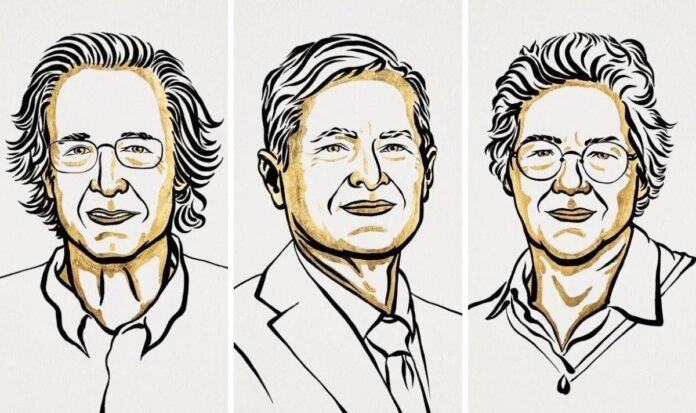Pierre Agostini, Ferenc Krausz and Anne L’Huillier have been awarded the 2023 Nobel Prize in Physics (Image: Niklas Elmehed / Nobel Prize Outreach) The Royal Swedish Academy of Sciences has jointly awarded Pierre Agostini, Ferenc Krausz and Anne L’Huillier the 2023 Nobel Prize in Physics for their work in studying electrons via super-brief light flashes. The honor was bestowed in recognition of their ‘experimental methods that generate attosecond pulses of light for the study of electron dynamics in matter’. The trio has been awarded a prize fund of 11 million Swedish kronor ($1million), which will be shared between them. This is the second Nobel Prize announcement of this week, following yesterday’s award of the Nobel Prize in Physiology or Medicine to Katalin Karikó and Drew Weissman for their work developing mRNA vaccines in the fight against COVID-19. The Nobel Prize in Chemistry will be announced tomorrow, Literature on Thursday and the Peace Prize on Friday — followed by the Sveriges Riksbank Prize in Economic Sciences in Memory of Alfred Nobel on Monday. READ MORE: More than half of Americans cannot name even a single Nobel Prize winner Pictured: a Nobel Prize Medal (Image: Nobel Prize Outreach / Clément Morin) The world of electrons is one that is very rapid, with changes occurring within a few tenths of an attosecond. These are a unit of time so short that there are as many in one second as there have been seconds since the beginning of the universe. Through their work, Agostini (of the Ohio State University), Krausz (of Germany’s Max Planck Institute of Quantum Optics) and L’Huillier (of Sweden’s Lund University) have enabled the production of pulses of light so short they are measured in these fantastical small units. These ‘attosecond pulses’ thereby prove a way to provide images of process occurring within atoms and molecules. Eva Olsson — the chair of the Nobel Committee for Physics — said: ‘We can now open the door to the world of electrons. Attosecond physics gives us the opportunity to understand mechanisms that are governed by electrons. The next step will be utilizing them.’ The groundwork was laid by L’Huillier back in 1987, when she discovered that when she passed infrared laser light through a noble gas, it produced many different overtones of light. The Royal Swedish Academy of Sciences said: ‘Each overtone is a light wave with a given number of cycles for each cycle in the laser light. ‘They are caused by the laser light interacting with atoms in the gas; it gives some electrons extra energy that is then emitted as light.’ In 2001, Agostini succeeded in producing and studying a series of consecutive light pulses — each of which lasted a mere 250 attoseconds. Meanwhile, Krausz was simultaneously working on a different experiment which enabled him to isolate a single light pulse that lasted 650 attoseconds. Commenting on the announcement, physicist Professor Mete Atature of the University of Cambridge, said: ‘It is wonderful news that the Nobel prize winners for Physics in 2023 are three outstanding scientists who initiated the decades-long effort to understanding how the world works in the shortest timescale we have reached, the attosecond. ‘Pierre Agostini, Ferenc Krausz and Anne L’Huillier pushed this field forward over the last decades and are very worthy recipients. ‘The pursuit of short intense pulses over decades has allowed us to see how matter behaves at shorter and shorter timescales, they act as our highest-resolution meter stick for how the world works, if you will. ‘It had already given us the concept of femtochemistry, recognized by the 1999 Nobel chemistry prize for Professor Zewail. Thanks to short pulses, we learned how atoms in molecules move and interact with each other during a chemical reaction. ‘The 2023 prize recognises the amazing achievement of reaching more than thousand-times shorter timescale, the attosecond world, opening a brand-new window into watching how individual electrons move inside matter, with their full quantum mechanical properties intact. ‘There are various applications, but it is exciting that the recognition is on the fundamental scientific research.’ The Nobel Prizes are awarded each year for ‘contributions that conferred the greatest benefit to humankind in the areas of Physics, Chemistry, Physiology or Medicine, Literature and Peace. They are typically regarded as the most prestigious awards in these fields. The prizes were established by the Swedish chemist Alfred Nobel who — on his death in 1896 — left all of his ‘remaining realizable assets’ to set up the awards, with the first iteration being awarded in 1901. While apocryphal, a story goes that Nobel was motivated to create the prizes after reading his unflattering (and premature) obituary published by a French newspaper in error, shortly after the death of Alfred’s brother, Ludvig. The obituary is reported to have damned him for his invention of military explosives, saying ‘Le marchand de la mort est mort (‘The merchant of death is dead’) — and accusing Nobel of becoming rich by finding ways to kill people ‘faster than ever before’. Follow our social media accounts on https://www.facebook.com/ExpressUSNews and @ExpressUSNews
Nobel Prize in Physics given to trio for study of electrons via light flashes
Sourceexpress.co.uk
RELATED ARTICLES


